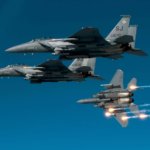In response to an attack on an air base where American troops were stationed, US forces conducted airstrikes against an Iran-backed militia in Iraq. Bloomberg reported that the three targets included the headquarters of Kataib Hezbollah, a training facility, and storage space for missiles and drones.
Simultaneously, the United States and the United Kingdom launched a second round of joint military strikes on Yemen’s Huthis on Tuesday. This action was prompted by the Huthis’ attacks on Red Sea shipping. The Iran-backed rebels had pledged to retaliate.
Residents of the rebel-held capital Sanaa reported the latest raids around midnight (2100 GMT). A joint US-UK statement mentioned hitting eight Huthi targets, while the Huthis claimed 18 strikes across their territory.
The first wave of strikes against the Huthi group occurred earlier this month, and additional US air raids targeted missiles deemed imminent threats to both civilian and military vessels.
Despite these actions, the Huthis persisted in their attacks on shipping, contributing to a growing crisis in the Middle East connected to the Israel-Hamas conflict. This situation has heightened concerns of a broader war directly involving Iran, according to AFP reports.
The recent US-UK strikes aimed to address the Huthis’ continued assaults on international and commercial shipping, along with naval vessels transiting the Red Sea. In a joint statement with other supporting countries, they explained that the precision strikes sought to disrupt and degrade the capabilities the Huthis used to threaten global trade and the lives of innocent mariners.
A separate statement from the US Central Command specified that the targets included missile systems and launchers, air defense systems, radars, and deeply buried weapons storage facilities.
The Huthis began targeting Red Sea shipping in November, citing attacks on Israeli-linked vessels in support of Palestinians in Gaza amid the ongoing Hamas-Israel war. The Huthis have since declared US and British interests as legitimate targets.
Navigating the Cost Surge: Air Force’s Dilemma with Next-Gen Nuclear Missile













